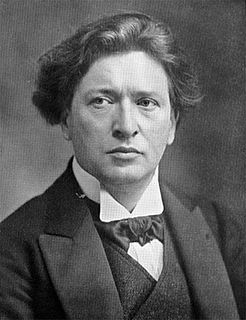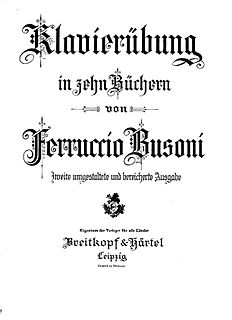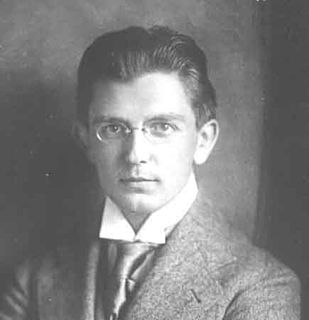| An die Jugend | |
|---|---|
| Solo piano pieces by Ferruccio Busoni | |
 The composer in 1906 | |
| Catalogue | BV 254 |
| Composed | 1909 |
An die Jugend(BV 254) is a sequence (or collection) of pieces of classical music for solo piano by Ferruccio Busoni.
| An die Jugend | |
|---|---|
| Solo piano pieces by Ferruccio Busoni | |
 The composer in 1906 | |
| Catalogue | BV 254 |
| Composed | 1909 |
An die Jugend(BV 254) is a sequence (or collection) of pieces of classical music for solo piano by Ferruccio Busoni.
The collection was written June–August 1909 and consists of four volumes, the last with an epilogue. It was published later in the same year by Zimmermann of Leipzig under four separate catalog numbers (Z 4755, Z 4756, Z 4757, and Z 4781). Each book takes about five minutes to play, and may be played separately, or together as a cycle. As in many other works by Busoni, it is compiled from transcribed, freely adapted, and original music. [1] [2]
The first performance, of Books 2, 3, and 4 (without "Epilogo"), was on 16 October 1909 in Bechstein Hall, London, with Busoni as the pianist. [4]
The materials of Book 1, and the "Epilogo," all related and highly original compositions, and written in the new style first explored in Elegien (BV 249), were later revised and combined with a new introduction and short linking passages presenting the thematic roots of the pieces and gluing them together into a single entity. The new piece, resembling a set of variations without a theme, Busoni entitled Sonatina (BV 257). This more advanced and forward-looking composition was the first of what would eventually be six "sonatinas" containing some of the most unusual and original piano music of the early 20th century. [2] [5]

Ferruccio Busoni was an Italian composer, pianist, conductor, editor, writer, and teacher. His international career and reputation led him to work closely with many of the leading musicians, artists and literary figures of his time, and he was a sought-after keyboard instructor and a teacher of composition.
The Bach-Werke-Verzeichnis is a catalogue of compositions by Johann Sebastian Bach. It was first published in 1950, edited by Wolfgang Schmieder. The catalogue's second edition appeared in 1990. An abbreviated version of that second edition, known as BWV2a, was published in 1998.

The Toccata and Fugue in D minor, BWV 565, is a piece of organ music written, according to its oldest extant sources, by Johann Sebastian Bach (1685–1750). The piece opens with a toccata section, followed by a fugue that ends in a coda. Scholars differ as to when it was composed. It could have been as early as c. 1704. Alternatively, a date as late as the 1750s has been suggested. To a large extent, the piece conforms to the characteristics deemed typical of the north German organ school of the Baroque era with divergent stylistic influences, such as south German characteristics.

The Fantasy on Themes from Mozart's Figaro and Don Giovanni, S.697, is an operatic paraphrase for solo piano by Franz Liszt, left as an unfinished manuscript upon his death, but completed by the pianist Leslie Howard and published in 1997. It has also been referred to as the "Figaro/Don Giovanni Fantasy" and is based on music from Mozart's operas The Marriage of Figaro (1786) and Don Giovanni (1787). Liszt composed the work by the end of 1842 or early 1843, as he performed it at the latest in Berlin on 11 January 1843.

The sonatas and partitas for solo violin are a set of six works composed by Johann Sebastian Bach. They are sometimes referred to in English as the sonatas and partias for solo violin in accordance with Bach's headings in the autograph manuscript: "Partia" was commonly used in German-speaking regions during Bach's time, whereas the Italian "partita" was introduced to this set in the 1879 Bach Gesellschaft edition, having become standard by that time. The set consists of three sonatas da chiesa in four movements and three partitas in dance-form movements. The 2nd Partita is widely known for its Chaconne, considered one of the most masterly and expressive works ever written for solo violin.

Fantasia contrappuntistica(BV 256) is a solo piano piece composed by Ferruccio Busoni in 1910. Busoni created a number of versions of the work, including several for solo piano and one for two pianos. It has been arranged for organ and for orchestra under the composer's supervision.

The Piano Concerto in C major, Op. 39 (BV 247), by Ferruccio Busoni, is one of the largest works ever written in this genre. The concerto lasts around 70 minutes and is in five movements; in the final movement a men's chorus sings words from the final scene of the verse drama Aladdin by Adam Oehlenschläger, who also wrote the words of one of the Danish national anthems.

Ferruccio Busoni discography chronicles the list of releases by the music artist.

The Klavierübung, by the Italian pianist-composer Ferruccio Busoni, is a compilation of piano exercises and practice pieces, comprising transcriptions of works by other composers and original compositions of his own.

Elegies, BV 249, by the Italian composer Ferruccio Busoni is a set of solo piano pieces which can be played as a cycle or separately. Initially published in 1908 with six pieces, it was subsequently expanded to seven by the addition of the Berceuse. The set of seven takes just over 40 minutes to play.

The Bach-Busoni Editions are a series of publications by the Italian pianist-composer Ferruccio Busoni (1866–1924) containing primarily piano transcriptions of keyboard music by Johann Sebastian Bach. They also include performance suggestions, practice exercises, musical analysis, an essay on the art of transcribing Bach's organ music for piano, an analysis of the fugue from Beethoven's 'Hammerklavier' sonata, and other related material. The later editions also include free adaptations and original compositions by Busoni which are based on the music of Bach.

The Turandot Suite, Op. 41 is an orchestral work by Ferruccio Busoni written in 1904-5, based on Count Carlo Gozzi's play Turandot. The music – in one form or another – occupied Busoni at various times between the years 1904–17. Busoni arranged the suite from incidental music which he was composing to accompany a production of Gozzi's play. The suite was first performed on 21 October 1905, while the play with his incidental music was not produced until 1911. In August 1916 Busoni had finished composing the one-act opera Arlecchino, but it needed a companion work to provide a full evening's entertainment. He suddenly decided to transform the Turandot music into a two-act opera with spoken dialog. The two works were premiered together as a double-bill in May 1917.

Alfred Hoehn was a German pianist, composer, piano pedagogue and editor.